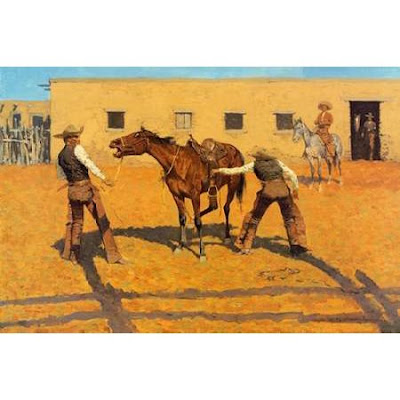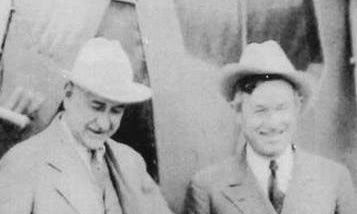Hello again,
Grrr! I had this post complete, I thought it was saved but Blogger was pulling the wool over my eyes and all was lost. Try, try again.
This weeks class was about 20th-century sculpture and painting with a bit of history thrown in. It was not live but a wonderful presentation recording of curator Shirley Reese-Hughes served as a great stand-in. In a way, it might have allowed us to concentrate on the PowerPoint presentation more. As usual, I will only hit a few of the highlights as she covered far too much territory for this little blog.
First up:
 |
Chef d'Orchestre 1919
|
This simplistic stained Cherrywood sculpture by Elie Nadelman says so much with so little. Elie was born in Poland and was aided by Helena Rubenstein, she who owned the great makeup empire, in coming to America during World War I. There was a lot of antisemitism at the time. He was interested in folk art as the beautiful Chef attests to. He and his wife lived well, collected folk art and even opened a museum to exhibit it. However; the stock market crash took it all. Elie taught sculpture for art therapy at the Bronx Veterans Hospital. Sadly Elie committed suicide when he found out the fate of many of his relatives in Poland during World War II.
.
 |
| Elie Nadelman (1882-1946) |
For a more in depth discussion on Eliasz (Elie) Nadelman see this web page
About Elie Nadelman
 |
| Louise Nevelson (1899-1988) |
Another sculpture presented to us is by Louise Nevelson who was brought to America in 1905 by her family to escape an oppressive government in the Russian Empire. Again antisemitism.
Louise was recycling before it became cool. Her works were created with found wood objects. She put them together and painted the resulting sculpture a brown color. To me, they look like they belonged together all the time. Stunning work from a woman when women were not encouraged to be artists. Louise was very successful. One of her quotes is "I only know you can't give advice to an artist" maybe that type of courage is why she was so successful. I would like to ask her why she called this piece Lunar Landscape. You will find out more about Louise here
About Louise Nevelson
 |
| Lunar Landscape 1959-1960 |
You might be thinking that the artists above were not born in America. That is OK as the art represented was made in America making it American art. Speaking of made in America, the next artist is one of the best this country ever produced. The one and only Georgia O'Keeffe. What a free, creative and talented spirit she was. I do not need to give you a website for Georgia. just google her and you will find hundreds. Her husband was the artistic photographer Alfred Stegliest. You can see her strong beauty in one of his many photos of her below.
 |
| Georgia O'Keeffe (1887-1986) |
Although Alfred lived in New York and Georgia lived in New Mexico their love continued on. She exhibited some of her paintings in his studio. You can see the age difference in the photo below
 |
| Georgia and Alfred |
Georgia's magnetic beauty is captured in this photo by Alfred below.
Now to show you a couple of her works. She loved flowers but did not try to capture the whole flower. This made her work even more interesting. She was disturbed that critics called some of her paintings sexual as that was not her intent. Notice how she draws your eye to the center of the flower by putting a bit of vertical yellow. A computer screen cannot possibly show the sheen and real beauty of this flower.
 |
| Red Cannas - 1927 |
Before we leave Georgia I have one more picture of hers. This particular church has been photographed and painted by many artists. Each in their own unique style. This is the back of the church found to be more interesting than the front. If you get to Taos, New Mexico check it out. Maybe do your own version of it.
 |
| Rancho Church - 1930 |
You do get a sense of the bare landscape in the area. Artists loved this area and as you may know, there is a big art colony in Taos and Santa Fe. You might even spot an alien or two if you look closely.
I have one more of the many artists shown to us in this class. He is Charles Demuth from Lancaster, PA. I chose him because like Georgia he is one of my favorites.
 |
| Charles Demuth (1883-1935) |
Charles painted beautiful watercolors and only turned to painting with oils later in his life. He was part of the precisionism movement. I am totally in love with his work. Spouse and I had a chance to go through his museum in his house in Lancaster. It is well worth the trip. See more on Charles here
More about Charles Demuth.
Talk about a small world. Charles was part of the Stieglitz group and was friends with Georgia O'Keeffe. He drew and painted many of the buildings in his hometown Lancaster. his work defies description so let us take a look at one.
 |
| Chimney and Water Tower - 1931 |
Now you can see why it is called precisionism. Every part of this painting is so well planned and splendidly executed. A very limited palette is all that is needed to achieve a painting that one can get lost in. Nothing goes to waste here.
Well, we made it to the end, again, and I believe this time I will be able to publish it. Remember you can get a taste of what is in the ACMAA here
http://www.cartermuseum.org/
Until next weeks class,
Caroline



















































